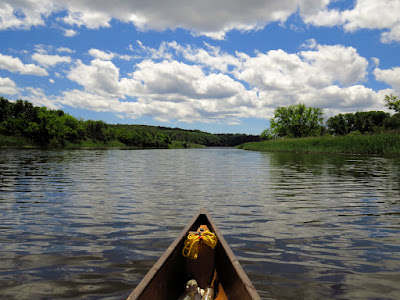I put in under the highway bridge again, but this time I head down river for a quick morning trip through the marsh. The tide is coming in and the river current has reversed, which it does for about 2 miles from the ocean. High tide isn't for three hours, so the current is mild. Otherwise, there is a nice breeze and mostly blue skies with a few small cumulus and some high cirrus.
I head down through Nell's channel and as I pass the sand bar with plenty of depth, it looks like my timing is good. A Black-Crowned Night Heron flies by. Halfway down the channel, the calls of Osprey increases in number and I pause to look around - two on a nest and eight overhead. Then, I see a Yellow-Crowned Night Heron in the spartina, and soon, a pair of them fly across the marsh in front of me.
 |
| Great Egret (yellow bill, black feet) and two Snowy Egrets (black bill, yellow feet) |
Milford Point has a zero bird count, although I bet there's a Piping Plover in the beach gravel. But heck, you can overlook those little magicians from ten feet away.
 |
| Mute Swans |
I head across the bottom of the marsh, spotting more turtles than birds. Then, up along the east edge where I see a couple of Snowy Egrets and a few Great Egrets. Take the secret inner route, finding that this tide level gives more than enough water to get through the entrance. At the far end of the inner route, I spot a pair of Swans with a snow white Cygnet. I've never seen a white Cygnet before - they are usually gray until they are a year old.
I head back up the river riding a current that does not make up for a stiffening head wind.


































